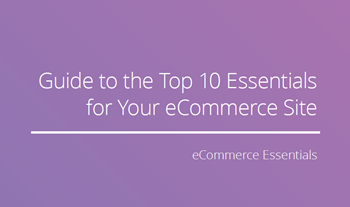In many ways, our world runs on data. As an ecommerce business, you'll not only have to deal with customers’ financial information but also the personal details of everyone who makes an account with you, as well as data from suppliers, partners and agencies you work with. Keeping all of this safe is therefore a crucial part of your role.
Data protection is often seen as a major task, but there are actually a few simple steps you can undertake that will have a big impact. You don’t need to have a degree in computer science to complete any of them, so you can confidently add them to your to-do list without worry. Here are our four simple tips that will help you protect your customer data.
1. Use a payment gateway
Your customers will likely already be wary about using your site because of the risk of fraud. Around 70% of people make their payment decisions based on whichever option is most secure, while 37% have abandoned making an online purchase because they didn’t feel safe.
With that in mind, if you aren’t using a secure payment gateway you could be turning away potential customers. Offering people an option like PayPal not only will make them feel safer, it will also ensure their data is kept secure. Major payment companies can afford to implement high-quality encryption, so as long as you’re careful about which you choose, it should be an easy way to protect your customer data.
2. Take the time to understand regulations
You’ve probably heard about the Payment Card Industry Data Security Standard (PCI DSS), which you should be abiding by if you want to take data protection seriously. However, have you actually sat down and read through it to make sure you understand what’s required of you? If you sell in the EU, the same applies to the General Data Protection Regulation (GDPR).
Verizon found that just 52.5% of organizations actually comply with PCI DSS, which is down from over 55% in 2017. This should be a simple aspect of data security, but too few businesses make use of these helpful guidelines. Make sure you’re not accidentally missing out by taking the time to understand the regulations you’re trying to follow.
3. Audit the data you hold
Losing customer data to a cyberattack could be incredibly costly. On average, businesses face cumulative costs of $2.4 million on average when a malware attack is successful. At the same time, the average cost per lost or stolen record per individual is $141. One way to limit the risk is to get rid of non-essential data, so there’s less for cyber criminals to actually steal.
It’s estimated that more than half of all the data a business keeps isn’t actually used. That’s a lot of information you could get rid of. It’s a good idea to conduct regular data audits to judge whether any of the data in your servers could be deleted, and to do so immediately. That way, you’ll have less to lose from a cyberattack.
4. Keep your site up-to-date
Finally, you need to make sure your site is updated regularly, especially when it comes to security protocols. Despite the HTTPS protocol becoming the industry standard - and having a negative effect on your Google search rankings if you don’t abide by it - just over half of the internet’s top one million sites actually use it.
Keeping your site security up to date means potential hackers will face greater difficulty in accessing information. Furthermore, ensuring you use the latest HTTPS protocol means your data is encrypted at the point of being transmitted, thereby improving your protection against any potential theft of data. This can be especially important in an ecommerce setting where sensitive personal information is regularly shared by the consumer.
Access the latest business knowledge in Marketing
Get Access



Comments
Join the conversation...